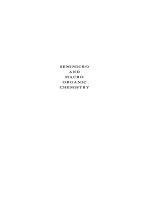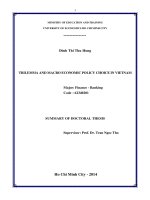vitamins and macro minerals
Bạn đang xem bản rút gọn của tài liệu. Xem và tải ngay bản đầy đủ của tài liệu tại đây (413.32 KB, 18 trang )
Minerals
•
•
•
•
Natural
Solid
Inorganic
Definite chemical
composition
• Crystal structure due
to internal
arrangement of
atoms
/>
/>
General Facts about Minerals
• Between 2 - 3,000 have been identified
• A few are “native elements” -- made of only
one element, such as sulfur, gold. copper,
and graphite (carbon)
• Most are compounds, especially the silicate
group (Si, O).
• Other important groups are oxides,
carbonates, and sulfides.
Less than a dozen are common
in most rocks
• Quartz
• Feldspar (group)
• Muscovite (white
mica)
• Biotite (black mica)
• Calcite
• Pyroxene
• Olivine
• Amphibole (group)
• Magnetite, limonite,
and other iron
oxides
• Pyrite
Common uses include:
•
•
•
•
•
•
•
Aluminum--packaging, transport, building
Beryllium--gemstones, fluorescent lights
Copper--electric cables, wires, switches
Feldspar--glass and ceramics
Iron--buildings, automobiles, magnets
Calcite--toothpaste, construction
/>
Minerals are identified by their
key characteristics
• hardness
• crystal shape
(form)
• luster
• color
• streak
• cleavage/fracture
• density (specific
gravity)
• special properties
--reaction to acid
--fluorescence
--salty taste
--magnetism
Mineral Hardness
• Ability to scratch
another mineral
• Mohs scale from 1
(talc) to 10
(diamond)
• Quartz (most
common mineral
and most dust
particles) is 7
/>
Crystal Shape (Form)
• External structure due
to internal
arrangement of the
atoms
• Six basic groups of
shapes, with about
three dozen variations
/>
Luster
• Describes how light
reflects off the surface
• Main categories are
“metallic” and “nonmetallic”
• Non-metallic includes
“dull,” glassy,” waxy,”
“pearly,” and
otherser
als.net/mineral/sulfides/
pyrite/pyrite2.htm
/>
Color
• results from ability to
absorb some
wavelengths and reflect
others
• some minerals have
characteristics colors
• others vary due to
chemical differences or
impurities (atoms mixed
inside the main elements)
/>
Streak
• Color of the powder
when rubbed on a
“streak plate”
(unglazed porcelain)
• May be same as handspecimen or different
• Some paint is based
on powdered minerals
(streaks).
/>
Mineral cleavage/fracture
• Some minerals split along flat surfaces when
struck hard--this is called mineral cleavage
• Other minerals break unevenly along rough or
curved surfaces--this is called fracture
• A few minerals have both cleavage and
fracture
Density (Specific Gravity)
• All minerals have
density (mass / volume),
but some are very dense
• Examples include
galena, magnetite, and
gold
• Specific Gravity is the
density of the mineral
compared with density of
water
/>
Special Characteristics-the “Acid Test”
Carbonates react
with dilute HCl and
other acids by
fizzing or bubbling
(releasing CO2 gas)
Special Characteristics-Fluorescence
• Some minerals will
glow when placed
under short-wave or
long-wave ultraviolet
rays
• Franklin and
Ogdensburg NJ are
famous for their
fluorescent minerals
/>
Special Characteristics-Salty Taste
• DO NOT TASTE
MOST MINERALS!
• Halite is the
exception--it will
taste salty
/>
Special Characteristics-Magnetism
• Many iron minerals
will produce an
invisible magnetic
force field
• “Lodestone” was
used by Vikings
more than 1,000
years ago as
compasses
/>
Useful Web Sites
• www.mii.org
• www.mineral.galleries.com/mineral
s
• www.mineral.net
• www.usgs.gov









